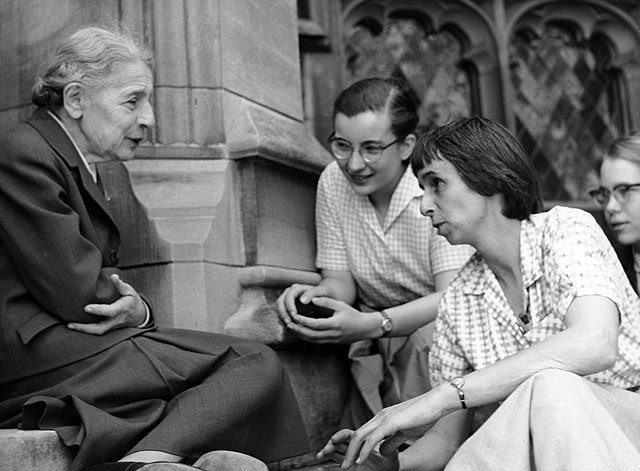
Professor Dorothy Hodgkin-by University of Bristol-Wikimedia Commons
20 Most Famous Female Scientists
Who are history’s greatest scientists? There’s a considerable chance that Albert Einstein, Isaac Newton, or other well-known figures come to mind. These researchers made outstanding discoveries that altered our perception of the universe. But too frequently, women are left off the list despite the fact that they have historically made important advances in science, especially during times when females were not allowed to pursue official education or employment in the era. The historical shadow cast by female scientists has just recently been lifted. Women have made significant contributions to science. Some of them have earned their rightful notoriety but others are less well-known. Here is a compiled list of 20 influential women in science history.
Top 20 Most Famous Black Scientists
1. Rosalind Franklin

Rosalind Franklin-by MRC Laboratory of Molecular Biology-Wikimedia Commons
Rosalind Elsie Franklin, a British chemist and X-ray crystallographer who lived from 25 July 1920 to 16 April 1958, made significant contributions to our understanding of the molecular structures of DNA (deoxyribonucleic acid), RNA (ribonucleic acid), viruses, coal, and graphite. While her contributions to the study of coal and viruses were recognized during her lifetime, the “dark lady of DNA,” the “forgotten heroine,” a “feminist icon,” and the “Sylvia Plath of molecular biology” have been used to describe her contributions to the discovery of the structure of DNA. The discovery of the DNA double helix, for which Francis Crick, James Watson, and Maurice Wilkins shared the 1962 Nobel Prize in Physiology or Medicine, was made possible by Franklin’s work on the X-ray diffraction images of DNA while she was a student at King’s College London.
2. Beatrice Shilling
Beatrice Shilling, an aeronautical engineer, and a daring motorcycle racer was born in Hampshire in 1909, and her colleagues credit her with aiding the allies in winning World War II. She earned a bachelor’s and master’s degree in mechanical engineering, focusing on the reduction of piston temperatures in high-speed diesel engines. She fixed a problem that threatened pilots’ lives in March 1941. During the Battle of France and the Battle of Britain in 1940, Royal Air Force pilots learned that fighter planes powered by Rolls-Royce engines had a major stalling issue. A straightforward device, a brass thimble with a hole in the middle that could be readily inserted into the engine’s carburetor, was created to address this issue under the direction of Shilling and his small team. For a number of key years during the war, it was nevertheless used as a temporary solution to assist prevent engine stalls.
3. Janet Taylor

Janet Taylor Pickett and Kamala Harris 03-by Office of Kamala Harris-Wikimedia Commons
Janet Taylor, also known as Jane Ann Ionn, was an English astronomer, navigator, mathematician, and meteorologist. She established a school for the instruction of astronomy and navigation, produced a number of literature on these subjects, and managed a warehouse devoted to the sale, manufacture, and upkeep of navigational instruments. The East India Company, Trinity House, and the Admiralty all held great regard for and made recommendations for Her Academy. She received medals from the Kings of Prussia and the Netherlands in appreciation for her efforts, and her formula for determining latitude from height was hailed as “ingenious.” Taylor was one of the very few women who made scientific instruments in Victorian London.
4. Sophia Louisa Jex-Blake
Sophia Louisa Jex-Blake was an English physician, educator, and feminist who lived from 21 January 1840 until 7 January 1912. When she and six other women, known as the “Edinburgh Seven,” started studying medicine at the University of Edinburgh in 1869, she was the leader of the movement to guarantee women access to a university degree. She was a leading advocate for medical education for women and was instrumental in helping to found two medical schools for women in London and Edinburgh at a time when no other medical schools were training women. She was the first practicing female doctor in Scotland and one of the first in the wider United Kingdom of Great Britain and Ireland.
5. Dorothy Hodgkin
The Nobel Prize-winning British chemist Dorothy Mary Crowfoot Hodgkin born on 12 May 1910 – 29 July 1994 improved the method of X-ray crystallography to ascertain the structure of biomolecules, which became crucial for structural biology. The validation of the structure of penicillin, which Edward Abraham and Ernst Boris Chain had previously hypothesized, and the structure of vitamin B12, for which she became the third woman to win the Nobel Prize in Chemistry in 1964, are two of her most important findings. After 35 years of research, Hodgkin also clarified the structure of insulin in 1969.
10 of the Most Famous British Scientists
6. Katherine Johnson

Katherine Johnson 1983-by NASA-Wikimedia Commons
As a NASA employee, Katherine Johnson born August 26, 1918 – February 24, 2020, performed orbital mechanics calculations that were crucial to the success of the first and subsequent American crewed spaceflights. Johnson performed a trajectory study for Alan Shepard’s Freedom 7 Mission in 1961, which was the first American space mission. She and her coworkers had been among the American Space Race’s unsung heroes. But in 2015, President Barack Obama bestowed the Presidential Medal of Freedom, the country’s highest civilian honor, upon Johnson, who was then 97.
7. Sophia Louisa Jex-Blake
Sophia Louisa Jex-Blake was an English physician, educator, and feminist who lived from 21 January 1840 until 7 January 1912. She was one of the first women to practice medicine in Scotland and the rest of the United Kingdom of Great Britain and Ireland. She was also a leading advocate for women’s access to medical education, helping to found two medical schools for women in London and Edinburgh at a time when there were none.
8. Cecilia Payne-Gaposchkin

Cecilia Helena Payne Gaposchkin (1900-1979) (2)-by Smithsonian Institution-Wikimedia Commons
The American astronomer and astrophysicist Cecilia Payne-Gaposchkin born May 10, 1900 – December 7, 1979, argued in her 1925 Ph.D. thesis that stars were predominantly made of hydrogen and helium. Her ground-breaking result was initially disregarded since it went against accepted scientific theory at the time, which claimed that the Sun and Earth’s elements were almost identical. Later, more observations confirmed that she was correct. Her research on variable stars laid the groundwork for contemporary astrophysics. Payne-Gaposchkin was a lady of many firsts; the first to graduate from Radcliffe College with a Ph.D., the first to hold a faculty position at Harvard and the first to identify the chemical makeup of stars.
9. Helen Gwynne-Vaughan
A well-known English botanist and mycologist, Dame Helen Charlotte Isabella Gwynne-Vaughan was born on 21 January 1879 – 26 August 1967. Gwynne-Vaughan took on a variety of roles during her life. She began her career as a wealthy aristocrat and led the Women’s Auxiliary Army Corps (WAAC) in France during World War I, but she spent the majority of her career as a university professor who became well-known for her research on the study of fungi. From 1918 to 1919 she served as Commandant of the Women’s Royal Air Force (WRAF). She also worked as the Auxiliary Territorial Service’s Chief Controller from 1939 to 1941 during World War II (ATS).
10. Wally Funk

Wally Funk 2012-by Unknown-Wikimedia Commons
Mary Wallace Funk, an American aviator, commercial astronaut, and goodwill ambassador, was born on February 1st, 1939. She was a member of the Mercury 13 and the first female aviation safety investigator for the National Transportation Safety Board, a civilian flight instructor at Fort Sill, Oklahoma, and a Federal Aviation Agency inspector. At the age of 82, Funk broke John Glenn’s record for the longest space journey on July 20, 2021, while traveling in Blue Origin’s New Shepard spaceship during its suborbital voyage. She still holds the distinction of being the oldest woman to visit space. Funk is one of the final two remaining members of the Mercury 13 group, along with Gene Nora Jessen, and also the only one of the thirteen who has been to space.
Top 10 Facts about the U.S. Space & Rocket Center
11. Inge Lehmann
A Danish seismologist and geophysicist, Inge Lehmann ForMemRS (13 May 1888 – 21 February 1993) was a pioneer in her field. She discovered in 1936 that the Earth’s molten outer core is surrounded by a solid inner core. Prior to that, seismologists had the belief that the Earth’s core was a single molten sphere, but was unable to explain the detailed measurements of seismic waves from earthquakes that contradicted this theory. Lehmann examined the seismic wave measurements and came to the conclusion that for the seismic waves to match the observations, Earth needed to have a solid inner core and a molten outer core. Other seismologists verified Lehmann’s theory before accepting it. Lehmann lived for more than 104 years, making her one of the scientists with the longest lifespans.
12. Mary Anning
Mary Anning was an English paleontologist, fossil collector, and dealer who lived from 21 May 1799 to 9 March 1847. She gained international recognition for the discoveries she made in Jurassic marine fossil beds in the cliffs near the English Channel at Lyme Regis in the Dorset county of southwest England. The discoveries of Anning influenced how scientists think about ancient life and the history of the Earth. When she was twelve years old, she found the first ichthyosaur skeleton that was correctly identified. She also found the first two virtually complete plesiosaur skeletons, the first pterosaur skeleton discovered outside of Germany, and fish fossils. She also found that belemnite fossils included fossilized ink sacs similar to those of current cephalopods. Her studies were crucial in revealing that coprolites, commonly known as bezoar stones at the time, were actually fossilized feces.
13. Caroline Herschel

Herschel Caroline 1829-by M. F. Tielemanm-Wikimedia Commons
The discovery of several comets, including the recurring comet 35P/Herschel-Rigollet, which bears her name, was one of Caroline Lucretia Herschel’s most important contributions to astronomy. Herschel was a British astronomer of German descent, who lived from 16 March 1750 to 9 January 1848. She was the first woman in England to occupy a government position and the first woman in science to be paid a wage. She was also the first female scientist to publish research in the Philosophical Transactions of the Royal Society, receive the Royal Astronomical Society’s Gold Medal in 1828, and be named an Honorary Member of the organization (1835, with Mary Somerville).
14. Barbara McClintock
Barbara McClintock, an American scientist and cytogeneticist who received the 1983 Nobel Prize in Physiology or Medicine, lived from June 16, 1902, until September 2, 1992.McClintock began researching chromosomes and how they changed in maize reproduction in the late 1920s. She created the method for displaying maize chromosomes and used microscopic examination to illustrate numerous basic genetic concepts. She created the first genetic map of maize by connecting chromosomal areas to physical features. She developed transposition in the 1940s and 1950s and used it to show that genes are in charge of turning physical traits on and off. As other scientists supported the mechanisms of genetic change and protein expression that McClintock had shown in her maize study in the 1940s and 1950s, her work became well-understood in the 1960s and 1970s.
15. Lise Meitner
Elise Meitner, an Austrian-Swedish physicist, who lived from 7 November 1878 to 27 October 1968, is credited with discovering protactinium and nuclear fission. She discovered the radioactive isotope protactinium-231 in 1917 while conducting research on radioactivity at the Kaiser Wilhelm Institute. Meitner finished her Ph.D. work in 1905, making her the second woman from the University of Vienna to be awarded a physics doctorate. Meitner discovered that bombarding thorium with neutrons created various isotopes in the middle of 1938 at the Kaiser Wilhelm Institute along with chemists Otto Hahn and Fritz Strassmann. Later that year, Hahn and Strassmann demonstrated how uranium bombardment might create barium isotopes. Meitner and Frisch studied the phenomenon of such a splitting process in late December. They referred to it as “fission” in their study published in the February 1939 issue of Nature. This idea sparked the creation of the first atomic bomb during World War II and other nuclear weapons and reactors that followed.
16. Elizabeth Garrett Anderson

Elizabeth Garrett Anderson-by Walery-Wikimedia Commons
Elizabeth Garrett Anderson was an English doctor and suffragist who lived from 9 June 1836 to 17 December 1917. She was the first woman in Britain to earn a medical and surgical degree. She was a co-founder of the first hospital with a female staff, the first dean of a British medical school, the first woman elected to a school board in Britain, and the first female mayor of a British city when she served as Aldeburgh’s mayor.
17. Mary the Jewess
Known through the writings of Zosimos of Panopolis (fl. c. 300) and other authors in the Greek alchemical tradition, Mary or Maria the Jewess, also known as Mary the Prophetess, was an early alchemist. She lived in Alexandria during the first and third centuries A.D., according to Zosimos’ remarks. She is listed by French, Taylor, and Lippmann as one of the earliest alchemical authors, with their works dated to no later than the first century.
18. Valentina Tereshkova
Engineer Valentina Vladimirovna Tereshkova, a member of the Russian State Duma, and a former cosmonaut for the Soviet Union was born on March 6, 1937. Having flown a solo trip aboard the Vostok 6 on June 16, 1963, she is renowned for being the first and youngest woman in space. She spent over three days in space, completed 48 Earth orbits, and is still the only woman to have completed a solo space mission.
19. Grace Hopper

Grace Hopper-by James S. Davis-Wikimedia Commons
American mathematician, computer scientist, and rear admiral of the US Navy, Grace Brewster Hopper was born on December 9, 1906, and she passed away on January 1, 1992. She was one of the original programmers for the Harvard Mark I computer and one of the creators of the first linkers. Hopper was the first to develop the theory of machine-independent programming languages and using this theory, she later developed the FLOW-MATIC programming language to produce COBOL, an early high-level programming language that is still in use today.
10 Most Famous American Inventors
20. Jane Goodall

Jane Goodall HK-by Jeekc-Wikimedia Commons
English anthropologist and primatologist Dame Jane Morris Goodall, previously Baroness Jane van Lawick-Goodall, was born on April 3, 1934. Being regarded as the foremost authority on chimpanzees in the world, Goodall is best known for her 60-year investigation into the social and family relationships of wild chimpanzees. She is the creator of the Jane Goodall Institute and the Roots & Shoots initiative, and she has dedicated a great deal of her career to promoting animal welfare and conservation. She has been a member of the Nonhuman Rights Project’s board since 2022. She was designated a UN Messenger of Peace in April 2002. Goodall is a World Future Council honorary member.
Planning a trip to Paris ? Get ready !
These are Amazon’s best-selling travel products that you may need for coming to Paris.
Bookstore
- The best travel book : Rick Steves – Paris 2023 – Learn more here
- Fodor’s Paris 2024 – Learn more here
Travel Gear
- Venture Pal Lightweight Backpack – Learn more here
- Samsonite Winfield 2 28″ Luggage – Learn more here
- Swig Savvy’s Stainless Steel Insulated Water Bottle – Learn more here
Check Amazon’s best-seller list for the most popular travel accessories. We sometimes read this list just to find out what new travel products people are buying.










